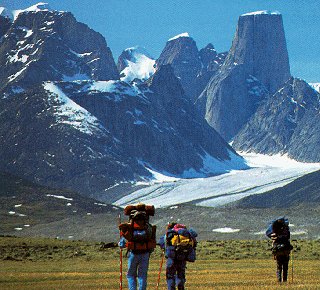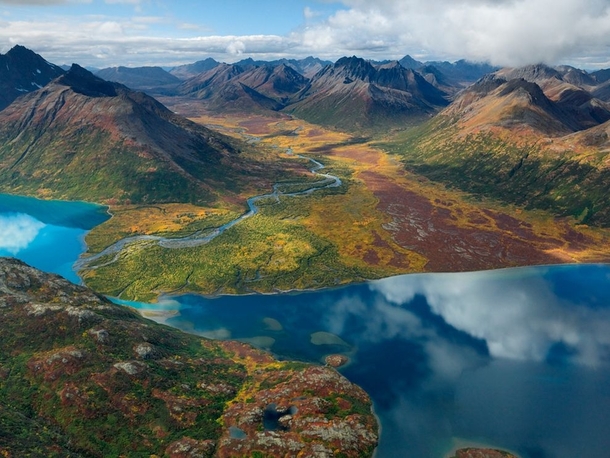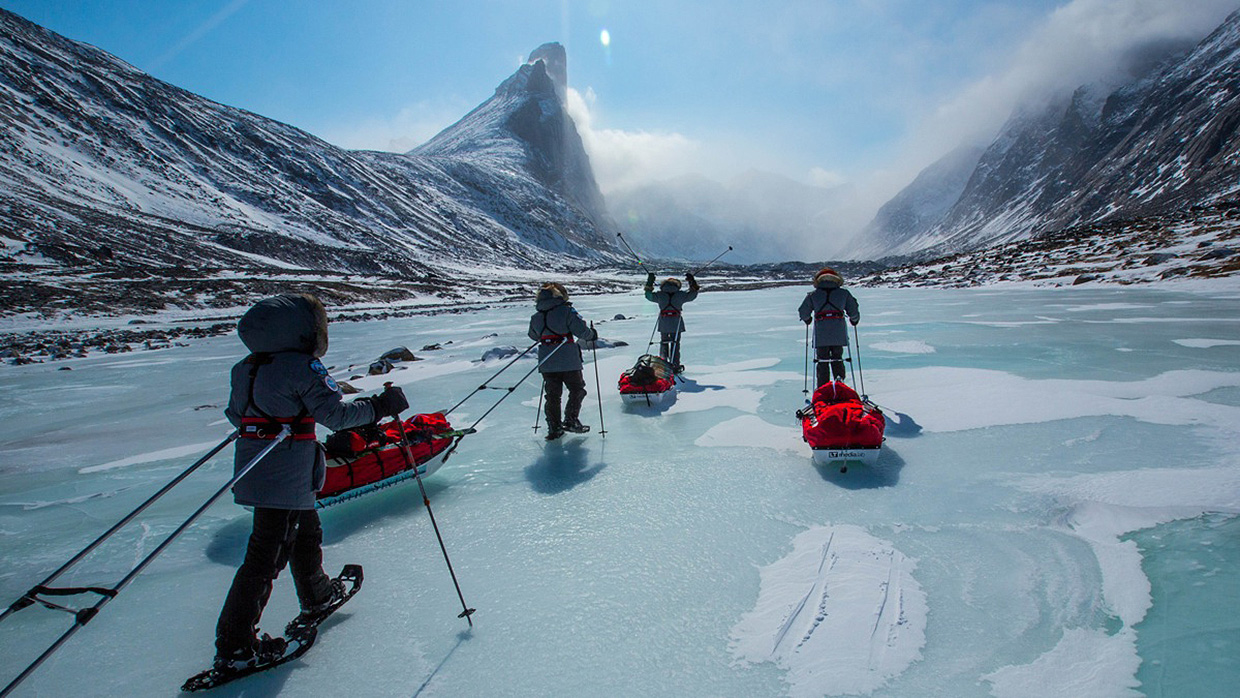The material - found in Canada's Baffin Island and in a region near the Solomon Islands - is about 4.5 billion years old, dating back to shortly after Earth formed.
The fact that these materials have survived billions of years hints at the limited of motion in Earth's interior and could shed more light on the birth of our planet.
Volcanoes have spewed out material created within the first 50 million years of the solar system's creation. The material - found in Canada's Baffin Island and in a region near the Solomon Islands - is about 4.5 billion years old, dating back to shortly after Earth formed
Scientists say the discovery could help researchers understand the processes that shaped our planet's birth.
Earth formed from the accretion of matter surrounding the young sun.
The heat of its formation caused extensive melting of the planet, leading Earth to separate into two layers when the denser iron metal sank inward toward the center.
This created the core, leaving the silicate-rich mantle floating above.
Over the subsequent 4.5 billion years of Earth's evolution, convection in Earth's interior - like water boiling on a stove - caused deep portions of the mantle to rise upwards.
This motion caused the mantle to separate once by density.
Pictured is Baffin Island, where a research team was able find a geochemical signature of material left over from the early melting events that accompanied Earth's formation
The mantle residues of crust formation were previously believed to have mixed back into the mantle so thoroughly that evidence of the planet's oldest events was lost completely. Pictured is a diagram of Earth's interior showing the crust (aluminium, silicate), the mantle (magnesium, silicate) and the core (iron, nickel)
EARTH'S FORMATION :
Earth is believed to have formed from the accretion of matter surrounding the young sun.
The heat of its formation caused extensive melting of the planet, leading Earth to separate into two layers when the denser iron metal sank inward toward the center.
This created the core, leaving the silicate-rich mantle floating above.
Over the subsequent 4.5 billion years of Earth's evolution, convection in Earth's interior - like water boiling on a stove - caused deep portions of the mantle to rise upwards.
This motion caused the mantle to separate once by density.
The melts, since they were less dense than the unmelted rock, rose to form Earth's crust, while the denser residues of the melting sank back downward, altering the mantle's chemical composition.
The mantle residues of crust formation were previously believed to have mixed back into the mantle so thoroughly that evidence of the planet's oldest geochemical events was lost completely.
However, the research team, which included scientists from Carnegie Melon University and the University of Maryland, was able find a geochemical signature of material left over from the early melting events that accompanied Earth's formation.
They found it in relatively young rocks both from Baffin Island, off the coast of northern Canada, and from the Ontong-Java Plateau in the Pacific Ocean, north of the Solomon Islands.
These rock formations are called flood basalts because they were created by massive eruptions of lava.
The solidified lava itself is only between 60 and 120 million years old, depending on its location.
But the team discovered that the molten material from inside the Earth that long ago erupted to create these plains of basaltic rock owes its chemical composition to events that occurred over 4.5 billion years in the past.
Rock formations, such as the one pictured, are called flood basalts because they were created by massive eruptions of lava. Pictured is Baffin Island
The research team found the material in relatively young rocks both from Baffin Island, off the coast of northern Canada, and from the Ontong-Java Plateau in the Pacific Ocean, north of the Solomon Islands
They made the discovery by measuring variations in these rocks to see the abundance of an isotope of tungsten—the same element used to make filaments of incandescent light bulbs.
Isotopes are versions of an element in which the number of neutrons in each atom differs from the number of protons.
These differing neutron numbers mean that each isotope has a slightly different mass.
The team's discovery offers new insight into the chemistry and dynamics that shaped our planet's formative processes
The team's discovery offers new insight into the chemistry and dynamics that shaped our planet's formative processes
Tungsten contains one isotope of mass 182 that is created when an isotope of the element hafnium undergoes radioactive decay, meaning its elemental composition changes as it gives off radiation. The time it takes for half of any quantity of hafnium-182 to decay into tungsten-182 is 9 million years.
This may sound like a very long time, but is quite rapid when it comes to planetary formation timescales. Rocky planets like Earth or Mars took about 100 million years to form.
The team determined that the basalts from Baffin Island, formed by a 60-million-year-old eruption from the mantle hot-spot currently located beneath Iceland, and the Ontong-Java Plateau, which was formed by an enormous volcanic event about 120 million years ago, contain slightly more tungsten-182 than other young volcanic rocks.
Because all the hafnium-182 decayed to tungsten-182 during the first 50 million years of solar system history, these findings indicate that the mantle material that melted to form the flood basalt rocks that the team studied originally had more hafnium than the rest of the mantle.
The likely explanation for this is that the portion of Earth's mantle from which the lava came had experienced a different history of iron separation than other portions of the mantle, since tungsten is normally removed to the core along with the iron.)
It was a surprise to the team that such material still exists in Earth's interior.
'This demonstrates that some remnants of the early Earth's interior, the composition of which was determined by the planet's formation processes, still exist today,' explained lead author Hanika Rizo, now at Université du Québec à Montréal.
'The survival of this material would not be expected given the degree to which plate tectonics has mixed and homogenized the planet's interior over the past 4.5 billion years, so these findings are a wonderful surprise,' added Richard Carlson, Director of Carnegie's Department of Terrestrial Magnetism.
The team's discovery offers new insight into the chemistry and dynamics that shaped our planet's formative processes.
Going forward, scientists will have to hunt for other areas showing outsized amounts of tungsten-182 with the hope of illuminating both the earliest portion of Earth's history as well as the place in Earth's interior where this ancient material is stored.
Going forward, scientists will have to hunt for other areas showing outsized amounts of tungsten-182 with the hope of illuminating both the earliest portion of Earth's history as well as the place in Earth's interior where this ancient material is stored.
Aunt Jeannie , this so interesting , we hope you enjoy it . Daddy posted it for us . Aunt Jeannie , we hope you are getting better .
Chris and I will be in high school this fall , everyone is passing to the next grade , Man will be in the 3 grade , Poppa and Man stay in trouble .
Aunt Jeannie , Chris and I have a business deliver packages UPS and Fed-Ex leave at the guard house , they drive to fast , we have lots of little kids . Adam and Eric will help us when we go on vacation . Hope you like the post . We asked Daddy how far from you was the Baffin Island , daddy said a long distance . Jenny said you know daddy is going to tell you to look it up .
From the Cubs . We love you very much .
Wrote by Jonny











These Strange creatures are called Narwhals. They are abundant around Baffin also whales and walrus and seals.
This one of two places Norwhals exist. The other is the Russian Arctic, where a few have been spotted. There are only 75,000 left in the world. They are endangered













Hope you are feeling better .
ReplyDeletego to wag
Wow! That was fascinating. Awesome to think something that old can still exist. From the photos, those rocks even look different from anything I have ever seen. I would love to get a chunk of that rock...wouldn't you. If that rock could speak, just imagine the secrets it could tell us. It could tell us how life was created and why we are here, messing up this planet. And I think the rock would tell us to smarten up before it's too late.
ReplyDeleteThank you so much. That is the most interesting thing I have read in weeks. I love old things but even I can't comprehend something that old.
I guess you guys are out of school now or will be pretty soon. Our kids have to wait until the end of June. Are you and Chris ready for high school? It is very different from anything you have experienced so far. It will be challenging but I think you enjoy a challenge. Will being in High school put an end to your debate team?? I sure hope not.
I think the job you and Chris made for yourselves is just great and is useful to all the folks in the compound. I wonder do they give you tips now and then. Sam and Jake are building themselves a fruit and vegetable stand. They live around farms and will buy produce from the farmers and sell it from their stand. They took a van and cut in half lengthwise and put a flat wooden bed over most of it to display fruit and vegetables, but they can still drive it on their property from place to place. They painted it bright green and white. They have a sign and are working on a canopy. They invented their own job just like you and Chris. They will do it most of the summer as each new crop becomes available. Stay creative and inventive my luv. That's what the world needs.
Don't worry about Man and Poppa until they stop getting in trouble. When that happens, get worried, because something must be wrong with them.
I think I am approximately 1600 miles from Baffin Island. Canada is so big, I couldn't see all of it if I lived to be a thousand years old. But some of it is boring flat plains that I wouldn't want to see and some of it is so wild you could not travel through it. And there are a lot of empty spaces where it is too harsh and wild to live. Baffin Island is wild and beautiful with lots of wildlife, including polar bears.
I am posting a Nasa video for you of Mercury passing the sun, which just happened.
Lots of love to all my cubs and loyal knights. Have a wonderful summer.
Hugs from Aunt Jeannie
PS: I put some photos of Baffin Island at the bottom of your post. It is really beautiful.
ReplyDeleteLuv Aunt Jeannie